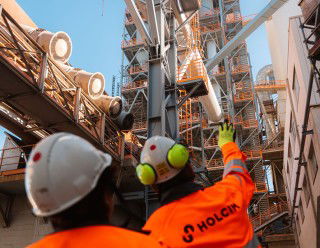This week, Vicat announced that its 1Q25 results recorded group consolidated sales of EUR886m, reflecting a 0.5 per cent rise at constant scope and exchange rates. While cement sales were virtually unchanged, volumes saw a 6.8 per cent decline in India, underlining the competitiveness of this fast-growing market. The group remains focussed on decarbonisation and implementing projects to reduce its carbon emissions.
Headquartered in France, Vicat sells 32 per cent of its cement in its domestic market, followed by 25 per cent in the Americas, 12 per cent in the Mediterranean and 11 per cent in both Asia and Europe, with the remaining 10 per cent in Africa. France has witnessed a slowdown in its residential market although sales for concrete and aggregates increased with stable cement prices. Vicat contributed modestly to the Lyon-Turin railway project, but its major announcement in France has been the launch of the consultation for its VAIA project. This EUR700m initiative will see a 1.2Mta carbon capture and storage (CCS) project at the Montalieu-Vercieu plant, as well as activated clay production in the Rhône Corridor. The project aims to reduce CO2 emissions by 0.2Mta.
In Europe (excluding France), sales moved higher in Switzerland and Italy. Switzerland saw the second consecutive quarter of volume growth in cement. Sales in Turkey and Egypt were impacted by the unfavourable weather conditions and cement prices were increased to offset production cost inflation. The Mediterranean markets gained momentum in exports moving higher volumes at improved prices.
American operations
Group operations in North America contrast widely with those in the Mediterranean as there are no imports or exports. Vicat’s subsidiary, National Cement, operates plants in Lebec, California, and Ragland, Alabama. The latter will be the featured plant tour of next week's IEEE-IAS/PCA 2025 Cement Conference and Exhibition, following the completion of a US$300m modernisation project that added 1.65Mta of cement capacity and increased alternative fuels. 1Q25 cement volumes fell in California amid weak residential markets. This was partially offset by growth in the US southeast and an upswing in Brazilian cement volumes, where prices remained stable, despite strong competition for sales in the centre-west region.
Competition in India
The Indian cement market proved challenging in the 1Q25, due to lower cement sales and an intensification in competition. However, the Maharashtra plant, which serves the Mumbai market, reported increased volume growth at the end of 2024, benefitting from rail infrastructure improvements.
Vicat also operates in Kazakhstan where cement volumes were slightly up in the Almaty region along with exports to Kyrgyzstan.
Investment in Senegal
In Africa, operations include Senegal, Mali and Mauritania. Resilient domestic volumes and lower exports characterised the market of Senegal. The arrival of a new competitor in Senegal has already exerted downward pressure on cement prices. Vicat intends to fight back, substituting clinker imports with locally produced clinker. A EUR260m capex project at the Sococim Industries’ Rufisque plant will replacement of Kiln Lines 3 and 4 with a 2Mta clinker modernisation plan, which will also reduce CO2 emissions. Kiln Line 6 is a new clinker line being installed by Fives FCB. It is due to be commissioned in the next week or two. Meanwhile, Mali and Mauritania reported lower sales in the 1Q25.
CEO comments on Vicat's 1Q25 performance
Commenting on the group's 1Q25 results, Vicat CEO, Guy Sidos, said: "The group has begun the year with stable sales, showing healthy resilience in France and business growth in Switzerland, which provides a foundation for a progressive recovery in residential demand in Europe... The first quarter also showed a very strong performance in Egypt, improved business levels in Brazil and a decrease in India owing to a fierce competitive environment.
"During this period of global uncertainties and limited economic visibility, Vicat's model, which is based on sound geographical diversification and local production serving local markets, represents a source of resilience supporting the group's profitable growth."
